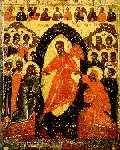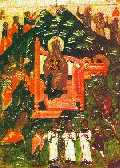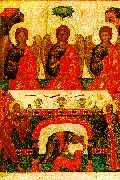





Pskov School icons: From left to right: The Anastasis (Descent into Hell) (14th c.), St. George Slaying the Dragon (16th c.), Synaxis of the Virgin (sec. half of the 14th c.), The Old Testament Trinity (15th c.).
The history of old Pskov was always connected with the struggle for independence. The "little brother" of Novgorod seems to have been always fighting against foreign invaders, even though, like Novgorod, Pskov was not affected by the Mongol conquest.
Pskov icons display less sophistication and artistry in execution than those of Novgorod, but they show a greater degree of poetic inspiration. Pskov icons have their own, particular style. The frescoes of Mirozhsky monastery were painted in a static and formal archaic manner. The icons of Pskov show a somber, but intense emotionalism. With time, the style of Pskov icons evolved, incorporating some elements from the Novgorodian art. From Novgorod the painters borrowed certain favorite topics and learned to use strong outlines which increased the graphic quality of their work. The earliest Pskov icons were monumental but the painters skillfully used intense colors (different from the toned-down colors of Kievan School) and created compositions with a strong rhythmic quality, often sacrificing the elegance of proportions to the dynamism of action. The painters of Pskov had a number of favorite compositions which they liked to replicate. Like the Novgorodians, they favored St. Nicholas and Elijah, but they also found inspiration in the stories of Christ's descent into Hell, the Nativity, and the Synaxis (gathering) of the Virgin. One of the distinguishing factors of Pskovian icons is the painters' preference of the deep "Pskovian" red and the deep "Pskovian" green. [K.T.]
[Source: Yamshchikov].
